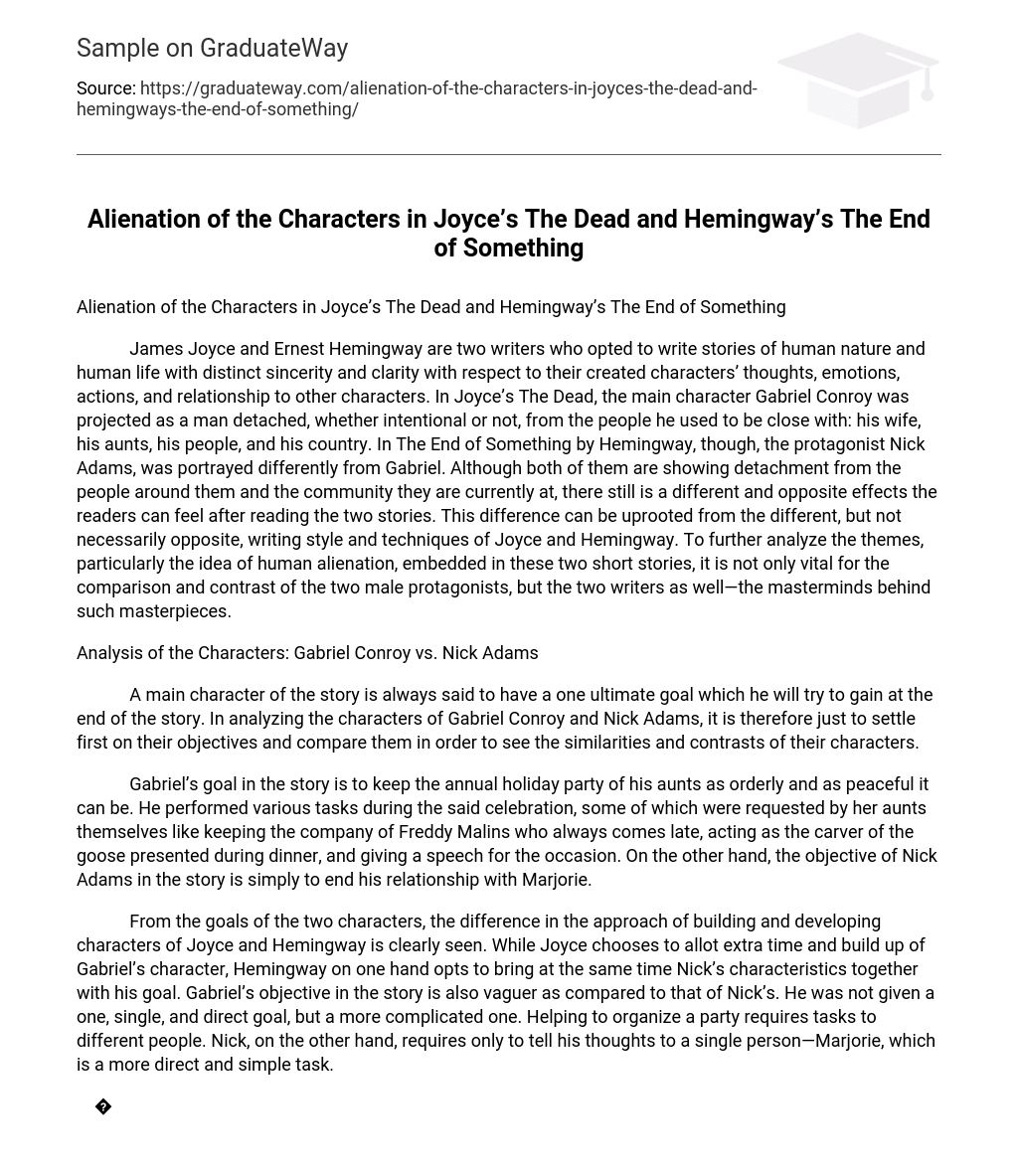James Joyce and Ernest Hemingway are two writers who chose to write stories about human nature and life with sincerity and clarity regarding their characters’ thoughts, emotions, actions, and relationships with others. In Joyce’s The Dead,” the main character Gabriel Conroy is portrayed as a detached man from the people he used to be close with: his wife, aunts, countrymen, and his country itself. On the other hand, in Hemingway’s “The End of Something,” protagonist Nick Adams is depicted differently from Gabriel. Although both show detachment from those around them and their community at large, readers experience different effects after reading each story due to the distinct writing styles of Joyce and Hemingway. To analyze the themes of human alienation embedded in these two short stories further requires not only comparing and contrasting the male protagonists but also examining both writers as masterminds behind such masterpieces.
Analysis of the Characters: Gabriel Conroy and Nick Adams
A main character in a story is often said to have one ultimate goal that they strive to achieve by the end of the story. When analyzing the characters of Gabriel Conroy and Nick Adams, it is important to first identify their objectives and compare them in order to see similarities and differences in their characters.
Gabriel’s goal in the story is to keep his aunts’ annual holiday party as orderly and peaceful as possible. He performs various tasks during the celebration, some of which are requested by his aunts themselves, such as keeping company with Freddy Malins who always arrives late, carving the goose presented during dinner, and giving a speech for the occasion. On the other hand, Nick Adams’ objective in the story is simply to end his relationship with Marjorie.
From the goals of the two characters, it is clear that Joyce and Hemingway have different approaches to building and developing characters. Joyce chooses to spend extra time building up Gabriel’s character, while Hemingway opts to bring Nick’s characteristics together with his goal. Additionally, Gabriel’s objective in the story is more complicated than Nick’s. While Nick only needs to tell his thoughts to Marjorie, helping organize a party requires delegating tasks to multiple people.
This difference in their objectives can be attributed to the environments they were in during the events. Gabriel was at a party, surrounded by people who may have influenced his behavior. In contrast, Nick was alone with Marjorie at the lakeshore and had no external pressures affecting him. Gabriel attempted to impress those around him by elevating himself, while Nick chose honesty with both Marjorie and himself by admitting his inability to continue their relationship.
In both stories, Hemingway and Joyce used the third-person point of view. However, there is a difference in the narration of the main characters’ thoughts and emotions. In The Dead, Gabriel has a freer flow of thoughts than Nick. This is evident in the story when Joyce gives Gabriel the chance to communicate with his readers through a passage that releases his thoughts: He was undecided about the lines from Robert Browning because he feared they would be above his hearers’ heads… He would only make himself ridiculous by quoting poetry they could not understand. They would think he was airing his superior education” (Joyce, 1993, p.129). This situation repeats in other parts of The Dead but never happens in The End of Something where readers only hear characters’ thoughts and sentiments through dialogue exchanges like when Nick confesses to Marjorie that “It isn’t fun anymore” (Hemingway, 2004, p.518). Consequently, readers have fewer clues about what’s happening in The End of Something compared to those who are like moviegoers with free passes into Gabriel’s mind while reading The Dead. It’s easier for them to relate and sympathize with Gabriel because his sentiments are more accessible than Nick’s.
It is now clear why readers seem less alienated by Gabriel and more detached from Nick. Although both writers address human alienation in their stories, the idea’s effect is projected to readers differently. Joyce and Hemingway have different writing styles for these two particular stories, raising the question of whose style is more effective. If it is Joyce’s technique, readers are free to know and sympathize with the characters, making it a reader-friendly style. However, this kind of writing can lead to criticism of Joyce for feeding his readers too much information and making them appear incapable of reading the subtext of the story. On the other hand, if it were Hemingway’s approach, readers may feel alienated while reading about the characters’ experiences – a negative aspect in literature.
Alienation is portrayed by both Gabriel and Nick, but they use different approaches. Joyce creates sympathy for Gabriel in his depiction, while Hemingway’s style creates a character who is detached not only from the people within the story but also from those outside of it. Despite this difference, both authors successfully depict the theme of alienation.
References
Demas, C. and Various, Mjf. (2004). Great American Short Stories: From Hawthorne to Hemingway. Spark Educational Publishing: USA.
Joyce, J. (1993). Dubliners. Penguin Books: England.





